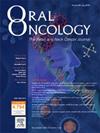大涎腺癌的全身转移模式及其治疗意义
IF 4
2区 医学
Q1 DENTISTRY, ORAL SURGERY & MEDICINE
引用次数: 0
摘要
本研究旨在探讨唾液腺癌(SGC)的转移扩散模式及其治疗意义。SGC的全身转移模式、转移后生存和危险因素尚未明确定义,并且SGC少转移概念的有效性从未被探讨过。方法对199例伴有全身转移的SGC患者进行回顾性研究。主要结局是转移后疾病特异性生存,并对危险因素进行多变量生存分析。将患者分为腺样囊性癌(ACCs)、非acc高级别肿瘤和非acc中、低级别肿瘤三个病理组。结果诊断为全身转移后中位生存期为28.9个月。仅有30%的患者出现少转移(≤3个转移灶,≤2个受累器官),70%的患者出现多转移(单器官多转移33.7%,多器官多转移36.2%)。患者身体状况差、无转移间隔短、非acc高级别肿瘤、并发局部疾病和多器官多转移被认为是远处转移后生存的独立危险因素。值得注意的是,伴有少转移和单器官多转移的SGC患者的生存结果相似。全身化疗并没有显著提高SGC患者的转移后生存。然而,HER-2靶向治疗联合化疗延长了表达c- erbb - b2肿瘤的转移后生存期。结论SGC多发多脏器转移,影响患者生存。为改善SGC患者的转移后预后,应进一步寻求肿瘤生物学治疗。本文章由计算机程序翻译,如有差异,请以英文原文为准。
The patterns of systemic metastasis in major salivary gland cancer and therapeutic implications
Background
This study aimed to investigate the patterns of metastatic spread of salivary gland cancer (SGC) and their therapeutic implications. Patterns of systemic metastasis, post-metastasis survival, and risk factors have not been defined clearly in SGC, and the validity of the concept of oligometastasis in SGC has never been explored.
Methods
This was a retrospective study of SGC patients with systemic metastasis (N = 199). The primary outcome was post-metastasis disease-specific survival, and multivariable survival analyses for risk factors were performed. The patients were divided into three pathology groups, adenoid cystic carcinomas (ACCs), non-ACC high-grade tumors, and non-ACC intermediate or low-grade tumors.
Results
Median survival was 28.9 months after diagnosis of systemic metastasis. Only 30 % of patients had oligometastasis (≤ 3 metastatic lesions and ≤ 2 involved organs), and polymetastasis was observed in 70 % (33.7 % single organ polymetastasis and 36.2 % multi-organ polymetastasis). Poor patient performance status, shorter metastasis-free interval, non-ACC high-grade tumor, concurrent local disease, and multi-organ polymetastasis were identified as independent risk factors for post-distant metastasis survival. Of note, SGC patients with oligometastasis and single organ polymetastasis showed similar survival outcomes. Systemic chemotherapy did not improve post-metastasis survival of SGC patients significantly. However, HER-2 targeted therapy combined with chemotherapy extended post-metastasis survival in c-erb-B2 expressing tumors.
Conclusions
Systemic metastasis into multiple organs is a common pattern of SGC metastasis, and significantly affects patient survival. Tumor biology-based therapy should be further sought for improving post-metastasis outcomes of SGC patients.
求助全文
通过发布文献求助,成功后即可免费获取论文全文。
去求助
来源期刊

Oral oncology
医学-牙科与口腔外科
CiteScore
8.70
自引率
10.40%
发文量
505
审稿时长
20 days
期刊介绍:
Oral Oncology is an international interdisciplinary journal which publishes high quality original research, clinical trials and review articles, editorials, and commentaries relating to the etiopathogenesis, epidemiology, prevention, clinical features, diagnosis, treatment and management of patients with neoplasms in the head and neck.
Oral Oncology is of interest to head and neck surgeons, radiation and medical oncologists, maxillo-facial surgeons, oto-rhino-laryngologists, plastic surgeons, pathologists, scientists, oral medical specialists, special care dentists, dental care professionals, general dental practitioners, public health physicians, palliative care physicians, nurses, radiologists, radiographers, dieticians, occupational therapists, speech and language therapists, nutritionists, clinical and health psychologists and counselors, professionals in end of life care, as well as others interested in these fields.
 求助内容:
求助内容: 应助结果提醒方式:
应助结果提醒方式:


